There is a lot of information online about how to make your workspace function better to support your body. Almost everyone becomes an expert in what is the perfect posture…but why does it matter? Keep reading to get some context for some of those often-recommended changes.
Recommendation
Set chair height so that shoulders can relax down with elbows bent at 90deg to reach a keyboard.
Context
Many people will set their chair height so that their feet can reach the floor. If someone is used to having tension in their shoulders, a desk sitting higher up on their torso may feel most normal.
The problem with this typical set-up is it actually causes shoulder tension, stemming from the shoulders chronically lifting. Shoulder/neck tension is one of the most common complaints from desk work.
The fix? Set the chair height so the shoulders are relaxed and the elbows are at 90deg.
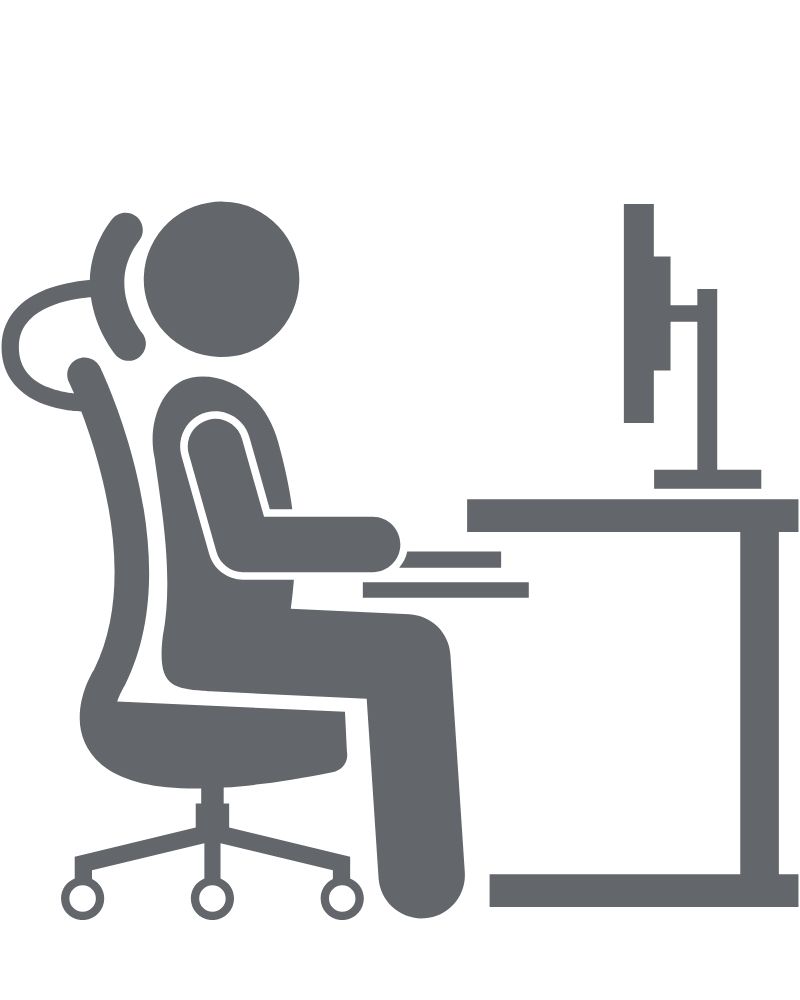
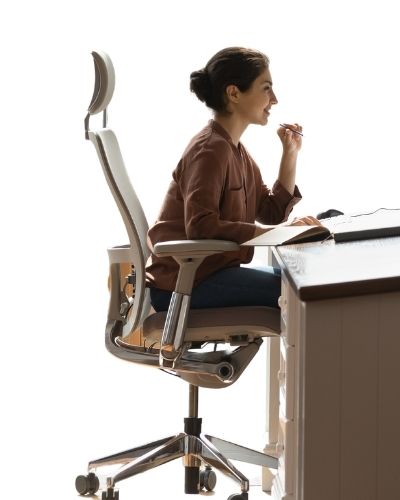
Recommendation
Elbows should be hanging straight down.
Context
If we allow our elbows to go out wide from our body (instead of hanging straight down), we are more likely to engage those shoulder-shrugging muscles (do tight upper traps sound familiar?). If we don’t want to wear our shoulders like earrings, the key is to drop our elbows on the chair.
Recommendation
Have them both.
Context
There are natural lordotic curves (bends in the spine where it curves toward the front of the body) in our cervical (neck) and lumbar (low back) spine. When we sit in a chair without these supports for an extended period of time, the muscles along our spines have to work harder to hold us in these postures, start to fatigue, and eventually cause back pain.
Using supports delays muscle fatigue and allows our natural curves and muscle lengths to remain in a healthier position for a longer period of time. Added bonus: better posture habits! ‘
The other most common pain complaints from desk work come from forward head posture. It is natural to bring your head closer to something you are focusing on visually, so many people won’t use a headrest. It can feel weird to use a head rest at first, but having a cervical support applies light pressure to the back of our necks, serving as a great feedback mechanism for keeping the head in the proper place.
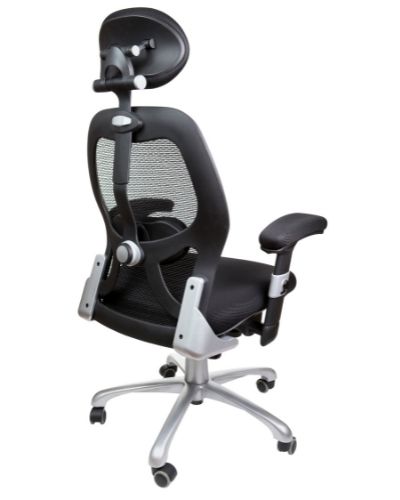
The heavy scoop that can be found in the seat and backrest for some stock office chairs can be more comfortable for short term use but is not ideal for long term use. Scooped seats can create hip issues, and heavily rounded (concave) backrests can contribute to the already problematic and prevalent rounded shoulders.
Recommendation
Use books or a foot stool to raise floor to feet, if knees hang below your hip crease.
Context
Having the legs hang low in such a way that the knees hang below the hip crease changes the rotation in the hips and can cause excessive forward rotation in the pelvis. Chronic forward pelvic rotation can create a cascade of issues starting with the low back and moving up the spine to the neck & jaw, or down to the ankles.
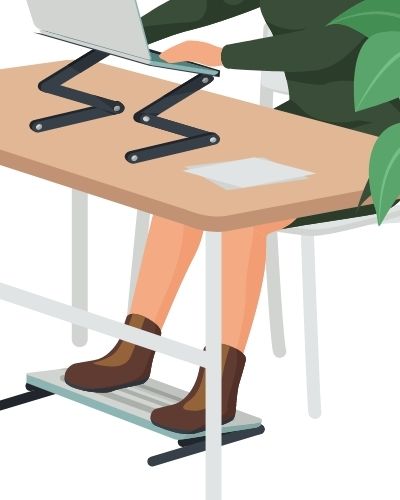
Recommendation
The top of the monitor screen should be at or slightly below eye level. Set your chair height first before you set your monitor height.
Context
The height of the monitor is going to affect your neck muscles, especially the short ones near the base of your skull (collectively referred to as the occipitals). Those little muscles play a big role in tension headaches. They can become cranky and demanding when left short for extended periods of time.
The right monitor height paired with proper cervical support (such as that neck/head rest) help keep those occipitals at a healthy length, and maybe will help keep tension headaches at bay.
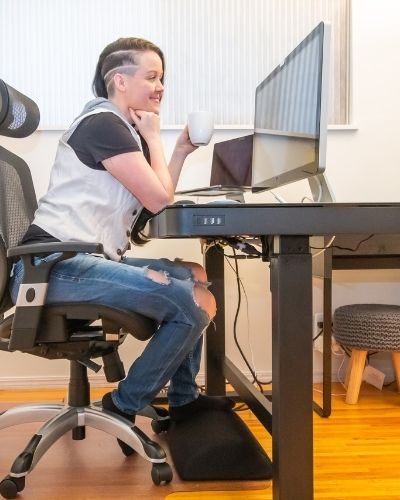

Recommendation
Position any monitor(s) at least 20 inches from your eyes. For larger screens, add more viewing distance.
Context
Your eyes use muscles to focus. These muscles can also contribute to headaches. Keep them happy by staying at a healthy distance from the screen and letting your eyes rest throughout the day.
Recommendation
If you have a single monitor, position it directly in front of where you are seated. If you have two monitors, you’ll need to consider how you use them. If you dominantly use one and only occasionally use the other, center the most used one in front and angle one to the side. If you use both fairly equally, angle and center them both. If you use three, center one in the middle, and angle the other two around. [photos for all options described]
Context
Repeatedly turning your neck in one direction more than another all day can wreak havoc by creating moderate to severe imbalance in the muscles that rotate your neck.



Recommendation
Position your keyboard in a way that keeps your wrists flat (i.e. forearms, wrists, and knuckles are all at the exact same height). A wrist pad can be helpful. The height of the keyboard should influence the height of your chair. An adjustable keyboard tray will allow for a lower chair height (remember chair height impacts monitor height). The goal is for the elbows to be about 90deg.
Context
Most of you have heard of that annoying, painful condition called carpal tunnel syndrome. Well, the carpal tunnel is located in the middle of your wrist joint. If our wrists are constantly bent backwards for keyboard typing, it will compress the carpal tunnel and can put you at risk for painful injury that is difficult to resolve.
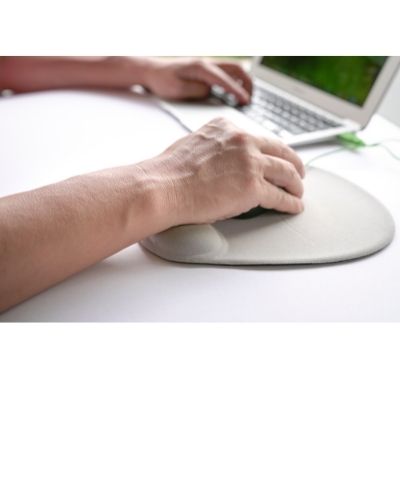
Recommendation
Use a sit-to-stand desk instead of a sitting desk. Our favorite options are sit-to-stand desks that are quick and simple to adjust. There are fancy electronic options that will raise and lower the whole table, or you can opt for a less expensive option that only raises and lowers the computer.
Context
It’s obvious right? Standing is better than sitting, because sitting kills, right?? Well, sort of. Just like sitting all day, standing in one place all day also creates a whole set of (different) issues. Muscles will still fatigue and you can still create significant imbalances and pain.
The best option is to change your position all day. Sit down with feet flat, cross a leg, cross the other leg, stand up, take a walking meeting, sit back down, stand later…you get the picture.

At the end of the day, the most important aspect of workplace ergonomics is listening to your body. General recommendations will improve wellness for most, but not all body types, and what works well for someone in the next office over may not be the best fit for you. That being said, we typically recommend giving a new set-up at least two weeks before changing again. Especially if you are not receiving maintenance body work, your body may not adjust as smoothly to a new set-up.
Just like when we make changes in care, muscle length and tone can change in a new set-up, and pain can accompany those initial changes, even if they will have long-term benefits. If you receive regular body work, and your body still hasn’t adjusted to a new set-up well within 2-3 weeks, that is a strong sign that you may not have the best set-up for you.